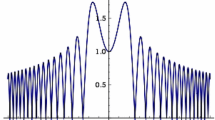Abstract
A theory of the model Hamiltonians within the framework of Rayleigh-Schrödinger perturbation theory is elaborated. The approach of a model Hamiltonian is based on the assumption that if it is diagonalized in a chosen model space it will yield eigenvalues of the original Hamiltonian in the entire Hilbert space. The theory of the model Hamiltonians may be fruitful as a theoretical background for the study of effective Hamiltonians and as natural extension of the standard Rayleigh-Schrödinger perturbation theory.
Similar content being viewed by others
References
Feshbach H., Ann. of Phys.8 (1958), 357;19 (1962), 287.
Löwdin P. O., J. Math. Phys.3 (1962), 969.
Bloch C., Horowitz J., Nucl. Phys.8 (1958), 91.
Freed K. F., Chem. Phys. Letters13 (1972), 181.
Bloch C., Nucl. Phys.6 (1958), 329.
Des Cloizeaux J., Nucl. Phys.20 (1960), 321.
Spiemsan G., Phys. Rev.107 (1951), 1180.
Primas H., Helv. Phys. Acta34 (1961), 331.
Primas H., Rev. Mod. Phys.35 (1963), 710.
Morita T., Progr. Theoret. Phys.29 (1963), 351.
Brandow B.,in Proceedings of International School of Physics “Enrico Fermi“, Course 36. (Ed. by C. Bloch.) Academic Press, New York 1966, p. 469.
Brandow B., Rev. Mod. Phys.39 (1967), 771.
Oberlecher G., Owono-N'-Guema F., Richter J., Nuovo CimentoB 68 (1970), 23.
Johnson M., Baranger M., Ann. of Phys.62 (1971), 172.
Kuo T. T. S., Lee S. Y., Ratcliff K. F., Nucl. Phys.A 176 (1971), 65.
Sandars P. G. H.,in Correlation Effects in Atoms and Molecules, Advances in Chemical Physics, Vol. 14. (Ed. by R. Lefebvre and C. Moser.) Interscience Publishers, New York 1969, p. 365.
Messiah A., Quantum Mechanics, Vol. II, North-Holland Publishing Co., Amsterdam 1962, Chapter XVI, § 14.
Kato T., Perturbation Theory of Linear Operators, Springer-Verlag, Berlin 1967.
Kato T., Progr. Theoret. Phys.4 (1949), 514.
Roman P., Advanced Quantum Theory, Addison-Wesley Publishing Co., Reading (Mass.) 1965, p. 320.
Halmos P. R., McLaughlin K., Pacif. J. Math.13 (1962), 585.
Halmos P. R., A Hilbert Space Problem Book, D. Van Norstrand Co., Princeton 1962, Chapter 13.
Author information
Authors and Affiliations
Rights and permissions
About this article
Cite this article
Kvasnička, V. Construction of model hamiltonians in framework of Rayleigh-Schrödinger perturbation theory. Czech J Phys 24, 605–615 (1974). https://doi.org/10.1007/BF01587295
Received:
Issue Date:
DOI: https://doi.org/10.1007/BF01587295



